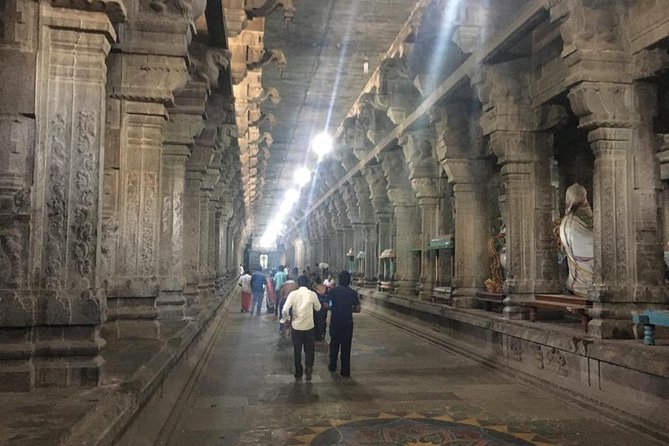
Mahabalipuram & Kanchipuram Day Tour
We are providing a private tour to Mahabalipuram and Kanchipuram in a single day. We are providing the best among all with experienced guide and drivers. We are not commercially oriented and only focus on satisfaction of the customers.
Options
Misc Services
Pickup included
What's included in Mahabalipuram & Kanchipuram Day Tour
(Subject to Option Inclusions)Itinerary
Pancha Rathas
The Five Rathas or Panch Rathas are five monolithic temple structures built by the Pallavas in early 7th century AD. Situated in a common complex to west of the Shore temple in Mahabalipuram, the Pancha Rathas display exquisite carvings carved out from a single large boulder. They are named after the Pandavas Yudhisthira, Arjuna, Bhima, Nakul, Sahadeva and their wife Draupadi. However as the names might suggest, the temples are not related to the Pandavas of Mahabharata fame but, unfinished masterpieces of the Pallava dynasty. The construction of the Rathas is believed to have been started by King Mahendravarman I of the Pallava dynasty. It was continued by his son Narasimhavarman I in early 7th century AD. The temple were however left incomplete after the Narasimhavarman I’s death. Based on the amazing ornamentation and sculptures however, it can be safely assumed that they were supposed to be temples dedicated to Lord Shiva, Vishnu, Indra and Durga. Pancha Rathas though belong to the very rare examples where whole buildings with ornate exterior and interior are cut from live cliff. The incredibly skilled Indian stonecutters here used a ridge of pink granite and, by removing the “spare” cliff, created a five structures – rathas – and three large monolithic sculptures among these structures. These monoliths of Mahabalipuram were declared a part of the UNESCO World Heritage Sites in 1984. The temples are shaped like Rathas or temple chariots with an exception that, there are no wheels. They are an excellent example of art from the Pallava times. These low-lying rock temples were influenced by Buddhist architecture as they were built in the same shape as pagodas, and greatly resemble the Buddhist vihara (monastery) and chaitya (temple hall). Their architecture most likely is much influenced by the architecture of wooden structures
Arjuna's Penance
Arjuna’s Penance is one of the magnificent monuments of Mahabalipuram. This wonderful bas air relief dates back to the mid-seventh century. Standing tall at a height of 43 feet, the monolith was carved on the face of two huge adjoining boulders, making its length around 96 feet. The majestic structure cannot be made out in photographs, it deserves to be praised by one’s own eyes. The subject of the massive structure is either Arjuna's Penance or the Descent of the Ganges, or possibly both. Historians and experts of archeology have never settled on one account as there are not sufficient sources or records. ‘Arjuna's Penance’ is an extract from the Mahabharata, of how Arjuna, one of the Pandavas, performed severe austerities in order to obtain Shiva's weapon. The concept of the story encompasses Hindu philosophy where it is believed that one could by penance, self-mortification, attain miraculous blessings from the Gods. The ‘Descent of Ganges’ story narrates the penance of Bhagirathi who performed austerities in order to bring Goddess Ganges down to earth. Lord Shiva consented to break the force of the descent of the river his hair, because otherwise the force would be too great for the earth to contain. The representation of the megalith relief supports either legend. The composition of the relief includes scenes of the natural and celestial worlds. A natural cleft populated by Nagas (snakes) separates the two halves of the relief. Water pours down this fissure imitating a waterfall or the Ganges' descent. Just above the shrine, Arjuna or Bhagiratha is carved standing on one leg, his arms upraised, in a yoga posture. Behind him appears Lord Shiva, holding a weapon and attended by celestial beings. In the natural world life-sized elephants are shown protect their young. There are also numerous other animals. The entire presentation is done with utmost skill.
Krishna's Butter Ball
The giant boulder appears to be frozen in its roll down the hill it sits on, and no one is quite sure why. The huge boulder is likely a glacial erratic that got stranded in a serendipitous position on the hill, but local legend has another version of the story. According to Hindu mythology, when the great god Krishna was just a baby, he was fond of stealing butter. Following this tradition, the big orange stone has been likened to a giant dollop of purloined butter that the god dropped. The actual name of the stone is “Vaan Irai Kal,” which translates to “Sky God’s Stone,” and according to one source, the more playful name was given to the rock by a local tour guide. However it got its sort of silly name, it stuck. Reinforcing the stone’s strangely balanced position, the slippery stone slope is used by local children as a slide. Today Krishna’s Butter Ball is a popular tourist attraction. Visitors to the site love to try to get behind the stone and try to push it down the hill. So far no human power has been able to budge the buttery boulder. Best of all, sometimes the local goats climb on top of it. It’s adorable.
Inclusions
- Air-conditioned vehicle
- All Fees and Taxes
- Coffee and/or Tea
- Lunch
- Public transportation options are available nearby
- Not recommended for travelers with spinal injuries
- Not recommended for pregnant travelers
- Suitable for all physical fitness levels
Meet
Pickup and Dropoff
Choose to be picked up from a list of locations
Please arrive at the pick up point 30 minutes before departure time.
Additional Information
We pick up from any part of Chennai city and Suburban area






